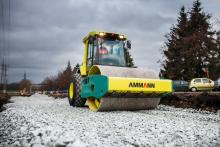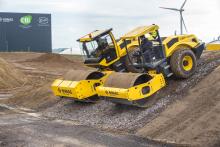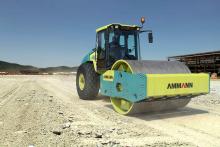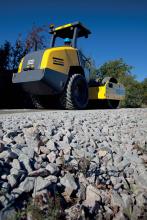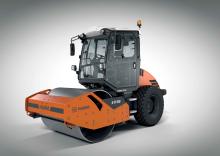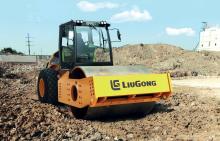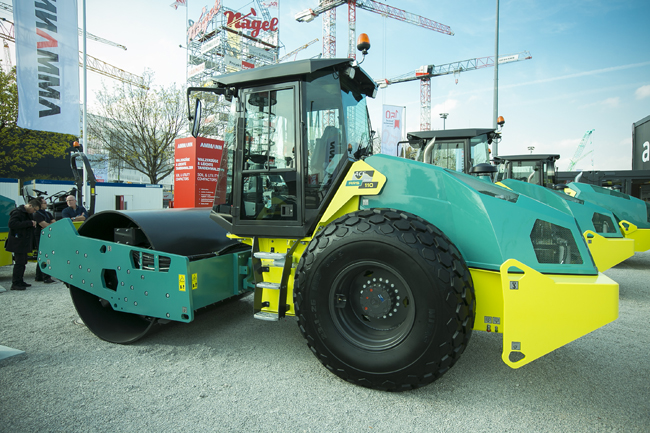
Construction equipment manufacturers continue to offer new solutions for all categories of machines and the soil compaction segment is no exception. A wide array of new machines is now coming to market, promising higher performance and effectiveness than before. Meanwhile, more advanced control systems means that while machines are more productive, they also develop better finish quality.
As with the firm’s other machines, the latest generation ARS compactors are offered telematics-ready, allowing fleet owners remote monitoring of operation and production performance as well as maintenance requirements.
The smallest of the new models is the ARS70, which weighs in at 6.5tonnes and is powered by a
One of the most interesting developments for the soil compaction market comes from
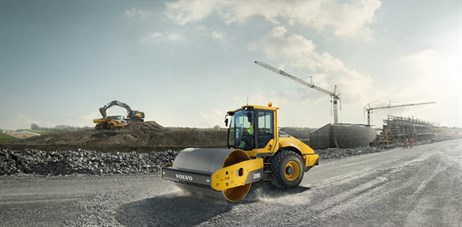
This is said to provide a significant boost to efficiency, while cutting compaction times. The system has been tested extensively and Dynapac claims that tests show it can reduce energy consumption by as much as 30% because the system ensures that only power required from the hydraulic system is diverted to the drum exciter. The package is now being offered as standard for the firm’s soil compactors from the CA1500 to the CA6500, along with the Dynapac Compaction Meter.
According to Dynapac, the system eliminates the problem of drums bouncing on ground that has already compacted, boosting efficiency further. In addition, the firm is now fitting its Evib system in the compaction meter to further maximise efficiency.
Because the new Seismic system is self-adjusting, it also eliminates the need for a final pass with a conventional deadweight roller, further cutting fleet costs for the user. And taking away the need for this final pass reduces the number of machines that a contractor needs onsite.
Designed for a more specific role, Dynapac is now offering special High Climb (HC) soil compactors. These are specially-adapted versions of the CA2500 and CA3500 models bearing HC logos and which meet the Stage IV and Tier 4 Final emissions requirements. A key feature of the High Climb models is that they are able to climb the same grade of slope, whether operating in forward or reverse. The High Climb application is suited to duties such as compaction in trenches and allows a machine to reverse up the grade of a trench, where turning around is unfeasible due to the narrowness.
This higher gradeability in reverse is possible as the machine is equipped with the firm’s latest Anti-spin versions of its NoSpin rear axles. To achieve this, the firm has used new, heavier components in the rear axle, drive, motor and transmission. The new configuration allows the drum to push the machine in reverse up a slope of 28°.
PD machines and D machines are fitted with pad shells to achieve a perfect grip in soil. However, the smooth drum versions also offer sufficient grip to drive the machines in reverse. Special mechanical stops have been added on the drive side of the drum, preventing unwanted overload of the rubber elements. In order to assist the operator, the displays on HC machines indicate both tilt and gradeability.
Both the new Seismic and HC soil compactors from Dynapac benefit from Stage V/Tier 4 Final emissions compliant engines.
Arch-rival
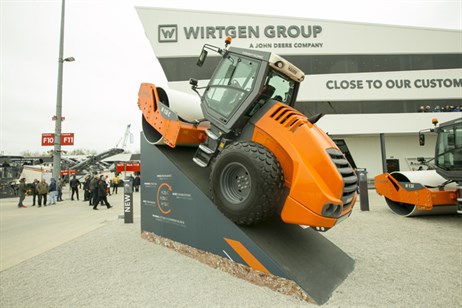
The package allows customers to document each pass, even when using continuous dynamic compaction control applications with oscillation. The system is available for the firm’s H 7i VIO and H 13i VIO compactors.
Also new for the soil compaction range are the C models, which benefit from extra climbing ability. The rollers have a more powerful hydrostatic drive that can deliver up to 30% more torque than a standard model. As a result, these models have better traction and climbing ability and can be used for heavy earthworks or compacting cohesive soils. However, the standard diesels are fitted so the machines deliver the same fuel economy as the standard models.
In addition, the firm is offering a redesigned dozer blade for use with its soil compactors. This has a revised geometry that allows more material to be moved and distributed than before. Special skid shoes are said to prevent the blade from digging into the ground and it has a patented, high-visibility cross member that allows a clear forward view. The dozer blade can also be controlled quickly and with precision due to a proportional valve. Two versions of the new dozer blade are available for H series compactors.
From
The SD115B, SD135B and SD160B soil compactors are said to offer a combination of versatility and performance.
To broaden the appeal of these models in emergent markets, the firm is introducing variants of the SD115B, SD135B and SD160B soil compactors available with Tier 3/Stage IIIA engine options for sale in territories such as the Middle East, Russia and CIS. The company says that while the engines can be used in markets where low sulphur fuel is not available, the machines retain the high performance and efficiency of the Stage V/Tier 4 Final compliant models.
The latest performance features for Volvo CE’s soil compactors include the advanced drum control system, which allows the operator to adjust the frequency and amplitude quickly and easily. These adjustments can be made using the control panel, compensating for changing soil types and conditions. Two frequency settings are fitted as standard, although five settings can be included as an option. High or low amplitude can be selected to adjust the drum’s dynamic force based on the job and material depth. In addition, the firm says that the optimised centrifugal force and auto-vibration feature help to further improve performance, ease of operation and productivity.
The latest traction system provides good climbing and traction capabilities in difficult applications, such as steep inclines or slippery surfaces, preventing wheel or drum spin for gradeability, performance and productivity.
The compactors are available with both smooth and padfoot drums. The smooth drum can also be converted to a padfoot drum by use of a clamp-on shell, increasing versatility.


